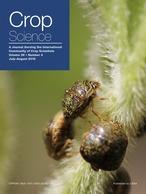African dry and starchy (DS) orange-fleshed sweetpotato [Ipomoea batatas (L.) Lam] (OFSP) cultivars, distinct from American moist or medium dry and sweet OFSP, have potential to fight vitamin A deficiency (VAD) in the world. This study assessed the genotype × environment (G × E) interactions in multienvironment trials (METs), the genetic correlations for total root yield (TYLD), biomass (BIOM), harvest index (HI), root dry matter (RDM), root starch (RST), root sucrose (RSU), root β-carotene, (RBC), root Fe (RFE), root Zn (RZN), root Ca (RCA), and root Mg (RMG) and the potential contributions of the cultivars to fight VAD and mineral deficiencies. Nine DS OFSP cultivars, (Ejumula, Zambezi, Carrot_C, Kakamega, KMI61, Abuket_1, SPK004/6/6, SPK004/6 and Naspot_5/50) and a medium dry and sweet OFSP cultivar (Resisto) were tested in METs in Uganda. The components were smaller than components for HI, RDM, RST, RSU, and RBC, making it possible to ably select for the traits in the early stages. The components were larger than components for TYLD and mineral traits. Thus, like yield, breeding for mineral traits in sweetpotato is complex, requiring prior data on the causes of the G × E interactions. Medium to high positive correlations among mineral traits favor parallel selection, and it merits further study to efficiently improve the mineral trait complex by an index. Clearly, a 50- to 100-g ration of all the cultivars, except Naspot_5/50, can provide 100% recommended dietary allowance of vitamin A for a 5- to 8-yr-old child.
Genotype x environment interactions for East African orange-fleshed sweetpotato clones evaluated across varying ecogeographic conditions in Uganda
Citation: Tumwegamire, S.; Rubaihayo, P.R.; Gruneberg, W.J.; LaBonte, D.R.; Mwanga, R.O.M.; Kapinga, R. 2016. Genotype x environment interactions for East African orange-fleshed sweetpotato clones evaluated across varying ecogeographic conditions in Uganda. Crop Science. (USA). ISSN 0011-183X. 56(4):1628-1644
2016-07-28
GENETICS, GENOMICS AND CROP IMPROVEMENT SCIENCES GGCI, SWEETPOTATO AGRI-FOOD SYSTEMS, SWEETPOTATOES
AFRICA, Eastern Africa
UGANDA
journal_article

